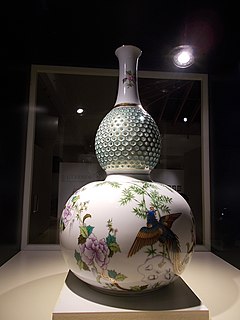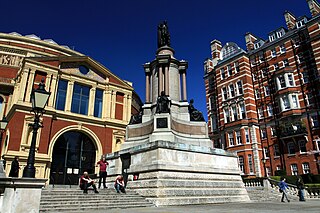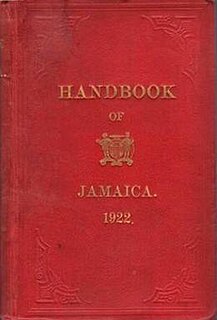
The Great Exhibition of the Works of Industry of All Nations or The Great Exhibition, an international exhibition, took place in Hyde Park, London, from 1 May to 15 October 1851. It was the first in a series of World's Fairs, exhibitions of culture and industry that became popular in the 19th century. The Great Exhibition was organised by Henry Cole and by Prince Albert, husband of the reigning monarch of the United Kingdom, Queen Victoria.

The Penny Black was the world's first adhesive postage stamp used in a public postal system. It was first issued in the United Kingdom, on 1 May 1840, but was not valid for use until 6 May. The stamp features a profile of Queen Victoria.

The International Exhibition of 1862, or Great London Exposition, was a world's fair. It was held from 1 May to 1 November 1862, beside the gardens of the Royal Horticultural Society, South Kensington, London, England, on a site that now houses museums including the Natural History Museum and the Science Museum.

Sir Kazimierz Stanisław Gzowski,, was an engineer best known for his work on a wide variety of Canadian railways as well as work on the Welland Canal. He also served as acting Lieutenant Governor of Ontario from 1896 to 1897.

Ernest Augustus was the reigning Duke of Brunswick from 2 November 1913 to 8 November 1918. He was a grandson of George V of Hanover, whom the Prussians had deposed from the Hanoverian throne in 1866, and Christian IX of Denmark.

Henry Constantine Richter was an English zoological illustrator who produced a very large number of skillful coloured lithographs of birds and mammals, mainly for the scientific books of the renowned English 19th century ornithologist John Gould.

Electrotyping is a chemical method for forming metal parts that exactly reproduce a model. The method was invented by Moritz von Jacobi in Russia in 1838, and was immediately adopted for applications in printing and several other fields. As described in an 1890 treatise, electrotyping produces "an exact facsimile of any object having an irregular surface, whether it be an engraved steel- or copper-plate, a wood-cut, or a form of set-up type, to be used for printing; or a medal, medallion, statue, bust, or even a natural object, for art purposes."

Empire Exhibition, Scotland 1938 was an international exposition held at Bellahouston Park in Glasgow, from May to December 1938.

William Theed, also known as William Theed, the younger was an English sculptor, the son of the sculptor and painter William Theed the elder (1764–1817). Although versatile and eclectic in his works, he specialised in portraiture, and his services were extensively used by the Royal Family.
This is a survey of the postage stamps and postal history of Jamaica.

The Herend Porcelain Manufactory is a Hungarian manufacturing company, specializing in luxury hand painted and gilded porcelain. Founded in 1826, it is based in the town of Herend near the city of Veszprém.

Plating refers to the reconstruction of a pane or "sheet" of postage stamps printed from a single plate by using individual stamps and overlapping strips and blocks of stamps. Likewise, if a sheet 10 or 20 postal cards is typeset, the variations of the letters or design elements may allow reconstruction or plating of the sheets based on these differences.

Leonard Charles Wyon was a British engraver of the Victorian era most notable for his work on the gold and silver coinage struck for the Golden Jubilee of Queen Victoria in 1887 and the bronze coinage of 1860 with the second ("bun") head portrait, in use from 1860 to 1894.

Key type stamps are stamps of a uniform design that were widely used by colonial territories in the 19th and 20th centuries.

The Memorial to the Great Exhibition is an outdoor monument commemorating the Great Exhibition (1851) and depicting Albert, Prince Consort, designed by Joseph Durham with modifications by Sydney Smirke and located south of Royal Albert Hall in London, United Kingdom. Originally installed in the Royal Horticultural Society gardens in 1863, it was relocated to its current site during 1891–1893 when the gardens were reconstructed and Prince Consort Road was created.

Charles Washington Augero Eves, CMG, was a British merchant prominent in the trade between London and the West Indies, and a promoter of the products of Jamaica. He was the honorary commissioner for Jamaica at the Colonial and Indian Exhibition in London, 1886, and was appointed by the Secretary of State for the Colonies to represent Jamaica at the Colonial Conference of 1887.

Augustus Constantine Sinclair was the head of the Government Printing Office in Jamaica in the nineteenth century and the compiler with Laurence R. Fyfe of the annual Handbook of Jamaica, first published in 1881. He is credited with the idea of the Jamaica International Exhibition of 1891 but died on its opening day.

Lawrence Dalzelle Riky Fyfe was a British civil servant in the Colonial Secretary's Office in Jamaica who, with Augustus Constantine Sinclair, compiled the annual Handbook of Jamaica, first published in 1881. Together they also produced a number of other works relating to the island of Jamaica.

The Handbook of Jamaica was an official government handbook of Jamaica first published in 1881 and which continued until the 1950s.
Founded in the 1780s, Köhler & Son were independent makers of brasswind instruments in London until they were bought by Swaine & Adeney in 1907.



















